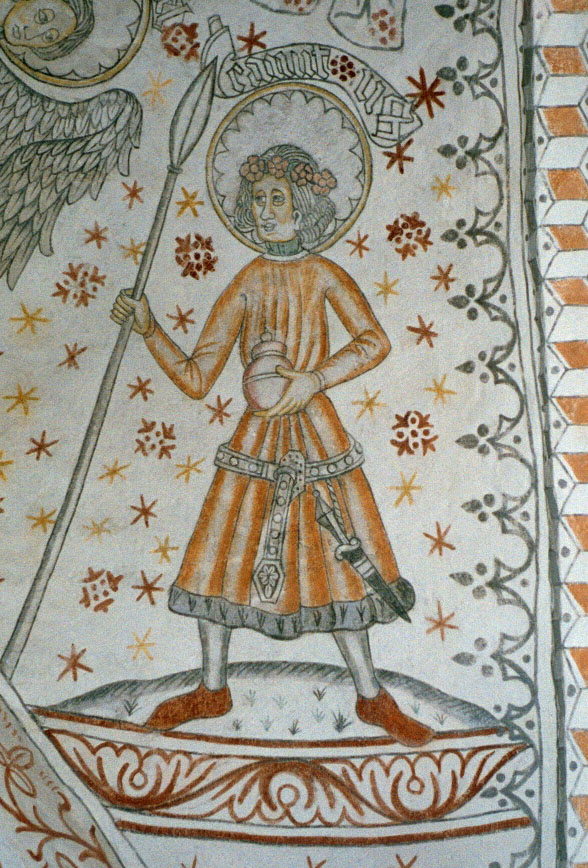© Unofficial Royalty 2025

Ekaterina Pavlovna of Russia, Queen Catherina of Württemberg; Credit – Wikipedia
May 10, 1403 – Death of Katherine Swynford, Duchess of Lancaster, 3rd wife of John of Gaunt, 1st Duke of Lancaster, a son of King Edward III of England, in Lincoln, England; buried at Lincoln Cathedral in Lincoln, England
Katherine Swynford was the long-time mistress and the third wife of John of Gaunt, 1st Duke of Lancaster, the fourth but the third surviving son of King Edward III of England and Philippa of Hainault. The descendants of Katherine Swynford and John of Gaunt are significant in English and Scottish history. The Tudor dynasty was descended directly from their eldest son John Beaufort, great-grandfather of King Henry VII of England, the first monarch of the House of Tudor. Katherine and John of Gaunt are the great-grandparents of King Edward IV and King Richard III from the House of York. Their granddaughter Joan Beaufort married James I, King of Scots, and was an ancestor of the Scots House of Stuart and the English House of Stuart.
Unofficial Royalty: Katherine Swynford, Duchess of Lancaster
May 10, 1726 – Death of Charles Beauclerk, 1st Duke of St Albans, an illegitimate son of King Charles II of England and Nell Gwynne in Bath, England; buried at Westminster Abbey in London, England
On April 17, 1694, Charles married Lady Diana de Vere, daughter of Aubrey de Vere, 20th Earl of Oxford, and the couple had twelve children. Charles Beauclerk, 1st Duke of St. Albans died on May 10, 1726, aged 56, in Bath, England. He was buried at Westminster Abbey in the Chapel of St. John the Evangelist, but he has no monument or marker. His wife Diana survived him by sixteen years, dying, aged 63, on January 15, 1742, at Windsor Castle in Windsor, England, and was buried in St. George’s Chapel, Windsor Castle in Windsor, England.
Unofficial Royalty: Charles Beauclerk, 1st Duke of St Albans
May 10, 1743 – Death of Melusine von der Schulenburg, Duchess of Kendal, mistress of King George I of Great Britain, at her home Kendal House in Isleworth, London, England; buried at Grosvenor Chapel in South Audley Street, London, England
In 1691, Melusine became the mistress of George, Electoral Prince of Hanover, the future Elector of Hanover and King George I of Great Britain. The future King George I had affairs while he lived in Hanover, but when his wife had one, she was divorced, sent off to a German castle for the rest of her life, and her lover disappeared, supposedly murdered. Melusine was more like a wife to George. She accompanied him to London when he became King of Great Britain and became a naturalized British citizen. After George I’s death, Melusine lived out the remainder of her life at her London home in the companionship of a large bird, probably a raven, in which she believed George’s soul had been reincarnated. Melusine died, aged 75, at her London home Kendal House.
Unofficial Royalty: Melusine von der Schulenburg, Duchess of Kendal, mistress of King George I of Great Britain
May 10, 1752 – Birth of Amalie of Zweibrücken-Birkenfeld-Bischweiler, Queen of Saxony, wife of King Friedrich August I of Saxony, in Mannheim, Palatinate-Zweibrücken-Birkenfeld-Bischweiler, now in Baden-Württemberg, Germany
Full name: Maria Amalie Auguste
At the time of her marriage, Amalie became the Electress of Saxony, the last to hold this title. In addition to three stillborn children, Amalie and her husband had one daughter. In 1806, Amalie became the first Queen of Saxony when the Electorate of Saxony was elevated to a Kingdom, and her husband assumed the throne as King Friedrich August I.
Unofficial Royalty: Amalie of Zweibrücken-Birkenfeld-Bischweiler, Queen of Saxony
May 10, 1774 – Death of King Louis XV of France at the Palace of Versailles; buried at the Basilica of Saint-Denis near Paris, France
When he was five years old, Louis XV succeeded his great-grandfather, King Louis XIV, and reigned as King of France for 59 years. He is the second-longest reigning King of France after his great-grandfather King Louis XIV, who reigned for 72 years. In 1725, Louis XV married Maria Leszczyńska, daughter of the deposed King Stanisław I of Poland. The couple had ten children, but all their sons predeceased Louis XV, and so he was succeeded by his grandson, the ill-fated King Louis XVI. King Louis XV died of smallpox at the Palace of Versailles on May 10, 1774.
Unofficial Royalty: King Louis XV of France
May 10, 1775 – Death of Caroline Matilda of Wales, Queen of Denmark, wife of King Christian VII of Denmark, sister of King George III of the United Kingdom, at Celle Castle in Celle, Duchy of Brunswick-Lüneburg, now in Lower Saxony, Germany; buried at Stadtkirche St. Marien in Celle
Soon after her marriage to her first cousin Christian VII, Caroline Matilda discovered he was severely mentally ill. Johann Friedrich Struensee, Christian’s doctor, had some success dealing with the king, but he also became the lover of the ill-treated Caroline Matilda, whose marriage was less than satisfactory. When the affair became known, Sturensee was brutally executed, and Caroline Matilda’s marriage was dissolved, she lost her title of Queen and was forcibly separated from her children whom she never saw again. She was held in custody for the rest of her life at Celle Castle in the Kingdom of Hanover. Her time in custody proved to be short. Three years later, Caroline Matilda died of “a putrid fever and sore throat,” probably scarlet fever at the age of 23.
Unofficial Royalty: Caroline Matilda of Wales, Queen of Denmark
May 10, 1788 – Birth of Queen Catherina of Württemberg, second wife of King Wilhelm I of Württemberg, born Grand Duchess Ekaterina Pavlovna of Russia at the Catherine Palace in Tsarskoye Selo, Russia
Catherina was the daughter of Paul I, Emperor of All Russia, and the sister of Alexander I, Emperor of All Russia, and Nicholas I, Emperor of All Russia. She had a short marriage and two sons with her first cousin Duke Georg of Oldenburg, who died from typhoid fever. She then married the future King Wilhelm I of Württemberg in 1816, and they had two daughters. Despite having a happy marriage, Wilhelm continued his relationships with numerous mistresses, including the Italian Blanche de la Flèche. When Catharina was made aware of this, she drove to Scharnhausen Castle on January 3, 1819, where she found Wilhelm and his mistress together. She quickly returned to Stuttgart, and just six days later, 30-year-old Catharina died of complications from pneumonia
Unofficial Royalty: Grand Duchess Catherine Pavlovna of Russia, Queen of Württemberg
May 10, 1794 – Execution of Madame Elisabeth of France, sister of King Louis XVI of France, at the Place de la Révolution in Paris; first buried in a common grave at the Errancis Cemetery in Paris, later reburied with other victims of the guillotine in the Catacombs of Paris
Elisabeth was devoted to her brother King Louis XVI and, with his permission, declined all marriage offers so that she could remain in France. She accompanied her brother and his family to imprisonment in the notorious Temple where they were imprisoned. On May 9, 1794, Elisabeth was transferred to the Conciergerie where she was tried and condemned to be executed the next day. She was executed by the guillotine at the Place de la Révolution in Paris (now called Place de la Concorde) with 23 other people. A very religious person, Elisabeth comforted and prayed with several others awaiting execution.
Unofficial Royalty: Madame Elisabeth of France
May 10, 1978 – Birth of Princess Lalla Salma of Morocco, former wife of King Mohammed VI of Morocco, born Salma Bennani in Fez, Morocco
On March 21, 2002, Salma Bennani married King Mohammed VI of Morocco at the Royal Palace in Rabat. She was granted the style Her Royal Highness and the title Princess Lalla. The couple had two children, Crown Prince Moulay Hassan, born in 2003 and Princess Lalla Khadija, born in 2007. In 2019, Éric Dupond-Moretti, King Mohammed’s lawyer, referred to Lalla Salma as the “ex-wife”, unofficially confirming the royal couple’s divorce.
Unofficial Royalty: Princess Lalla Salma of Morocco
May 10, 2020 – Birth of Prince Charles of Luxembourg, son of Hereditary Prince Guillaume of Luxembourg, at the Grand Duchess Charlotte Maternity Hospital in Luxembourg City, Luxembourg
Full Name: Charles Jean Philippe Joseph Marie Guillaume
Prince Charles is the second in the line of succession to the throne of the Grand Duchy of Luxembourg after his father.
Unofficial Royalty: Prince Charles of Luxembourg
This article is the intellectual property of Unofficial Royalty and is NOT TO BE COPIED, EDITED, OR POSTED IN ANY FORM ON ANOTHER WEBSITE under any circumstances. It is permissible to use a link that directs to Unofficial Royalty.













